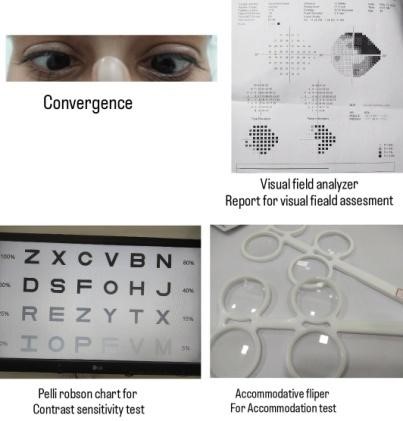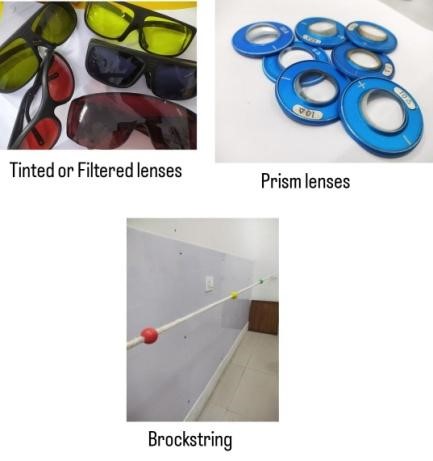Priyal Maheshwari, B. Optom.
Fellow Optometrist Dr. Shroff’s Charity Eye Hospital, New Delhi, India
The Hidden Epidemic: Vision Problems After Brain Injury
As many as 75% of individuals with brain injuries suffer from visual issues that frequently go unnoticed or are incorrectly diagnosed. (1) These visual challenges can continue well beyond the initial injury, affecting everyday activities, self-sufficiency, and emotional well-being. Despite this, patients are often reassured that their vision is normal because they pass basic eye exams. However, the real issue stems from the brain’s capacity to manage and make sense of visual information. (2)
Types of Vision Dysfunction After Brain Injury
Patients recovering from a Traumatic Brain Injury (TBI), stroke, or concussion may encounter a variety of neurological vision problems, such as (3)
| Symptom | Description | Estimated Prevalence (%) |
|---|---|---|
| Blurred or double vision (diplopia) | Difficultly seeing clearly or seeing two images | 20–40% |
| Photophobia (light sensitivity) | Discomfort or pain in bright lighting | 30–50% |
| Eye movement disorders | Poor tracking, fixation, or saccadic movements | 35–55% |
| Convergence insufficiency | Inability of eyes to work together at near distance | 43–56% |
| Visual field loss | Missing portions of visual field (e.g., peripheral vision) | 20–30% |
| Visual motion sensitivity | Dizziness/nausea triggered by motion in visual field | 30–40% |
| Difficulty reading | Skipping lines, losing place, or fatigue while reading | 30–60% |
| Poor depth perception | Trouble judging distances, e.g., stairs, pouring, driving | 25–35% |
| Visual fatigue/eye strain | Eyes tire quickly during screen use or close work | 40–50% |
Tablel 1: Vision Dysfunction After TBI and Its Prevalence
These dysfunctions often go unnoticed unless specifically tested, and they can severely impact balance, reading, concentration, driving, and more. (5)
Diagnostic Tools: Beyond the Eye Chart
Standard Snellen charts only measure static distance acuity. But diagnosing vision problems after a brain injury requires a neuro-optometric or neuro-ophthalmologic evaluation, including:
- Eye movement testing (saccades, pursuits)
- Vergence and convergence testing
- Visual field assessment
- Contrast sensitivity testing
- Accommodation/focus flexibility
- Dynamic visual acuity and tracking
- Visual Evoked Potentials (VEP) to assess cortical processing (6)

Figure 1: Diagnostic Tools
The Neurology of Vision: How the Brain Sees
Over half of the brain plays a role in processing visual information, involving areas like the occipital, parietal, and temporal lobes, as well as the brainstem and cranial nerves. (7) When any part of this complex system is damaged, it can interfere with how the brain interprets, combines, and reacts to what we see. This explains why even mild concussions can lead to significant visual disturbances. (8)
Management and Treatment Approaches
Fortunately, there are evidence-based interventions to manage post-TBI visual dysfunction:
- Tinted or filtered lenses: Reduce light sensitivity and enhance contrast.
- Environmental modifications: Adjust lighting, contrast, and visual stimuli to reduce overload.
- Prism lenses: Help correct alignment issues and field loss
- Vision therapy: Customised eye-brain exercises to improve focus, tracking, and coordination.
- Visual scanning training: Especially for hemianopia or neglect.
- Occupational therapy: Incorporates visual-motor integration tasks. (9)

Figure 2: Management and Treatment Approaches
Challenges in Diagnosis and Care
- Lack of training among general practitioners and optometrists.
- Under-referral to neuro-visual specialists.
- Misattribution of visual symptoms to psychiatric or cognitive issues.
- Limited insurance coverage for vision therapy or speciality evaluations.
- A shortage of trained neuro-optometrists, especially in rural areas. (10)
Future Directions and Scope
The future of brain-injury-related vision care lies in:
- Early screening protocols post-concussion or stroke.
- AI-assisted diagnostic tools to detect eye movement abnormalities.
- Tele-optometry for remote assessments.
- Greater integration of vision therapy in standard rehabilitation programs.
- Ongoing clinical research into neuroplasticity and visual rehab techniques. (11)
Conclusion
20/20 vision is only a small part of true visual health. For brain injury survivors, it is essential to go beyond basic vision screening and evaluate how the eyes and brain work together. Hidden vision problems can have a profound impact on recovery, however, with proper diagnosis and treatment, they do not have to be permanent. Recognising the signs and advocating for comprehensive care is the first step toward reclaiming clarity, comfort, and independence. (12)
References
- Armstrong, R. A. (2018). Visual problems associated with traumatic brain injury. Clinical and Experimental Optometry, 101(6), 716–726.
- Greenwald, B. D., Kapoor, N., & Singh, A. D. (2012). Visual impairments in the first year after traumatic brain injury. Brain Injury, 26(11), 1338–1359.
- Hellerstein, L. F., Freed, S., & Maples, W. C. (1995). Vision profile of patients with mild brain injury. Journal of the American Optometric Association, 66(10), 634–639.
- Ciuffreda & Ludlam (2011), Goodrich et al. (2007), Padula & Argyris (1996), Suchoff et al. (2008), and professional guidelines from COVD and NORA.
- Capó-Aponte, J. E., Urosevich, T. G., Temme, L. A., et al. (2012). Visual dysfunctions and symptoms during the subacute stage of blast-induced mild traumatic brain injury. Military Medicine, 177(7), 804–813.
- Rutner, D., Kapoor, N., & Ciuffreda, K. J. (2006). Occurrence of oculomotor dysfunctions in acquired brain injury: A retrospective analysis. Optometry, 77(1), 17–2
- Suchoff, I. B., Ciuffreda, K. J., & Kapoor, N. (2001). Visual and vestibular consequences of acquired brain injury. Santa Ana, CA: Optometric Extension Program Foundation.
- Master, C. L., Scheiman, M., Gallaway, M., et al. (2016). Vision diagnoses are common after concussion in adolescents. Clinical Pediatrics, 55(3), 260–267.
- Pollock, A., Hazelton, C., Henderson, C. A., et al. (2011). Interventions for visual field defects in patients with stroke. Cochrane Database of Systematic Reviews, 2011(10), CD008388.
- Singh, A., & Evans, B. J. W. (2019). The visual consequences of mild traumatic brain injury in adults. Visual Impairment Research, 21(3), 133–142.
- Johannsen, L., Brogaard, B., & Wehling, M. (2020). Patient perspectives on vision disturbances following brain injury: A qualitative study. BMC Health Services Research, 20(1), 852.
- Suchoff, I. B., Kapoor, N., & Ciuffreda, K. J. (2008). Visual and Vestibular Consequences of Acquired Brain Injury. Santa Ana, CA: Optometric Extension Program Foundation.


Recent Comments